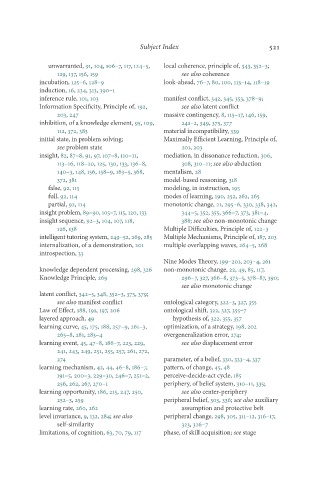Page 538 - Deep Learning
P. 538
Subject Index 521
unwarranted, 91, 104, 106–7, 117, 124–5, local coherence, principle of, 343, 352–3;
129, 137, 156, 159 see also coherence
incubation, 125–6, 128–9 look-ahead, 76–7, 80, 100, 113–14, 118–19
induction, 16, 234, 313, 390–1
inference rule, 101, 103 manifest conflict, 342, 345, 353, 378–9;
Information Specificity, Principle of, 192, see also latent conflict
203, 247 massive contingency, 8, 115–17, 146, 159,
inhibition, of a knowledge element, 95, 109, 241–2, 349, 375, 377
112, 372, 383 material incompatibility, 339
initial state, in problem solving; Maximally Efficient Learning, Principle of,
see problem state 201, 203
insight, 82, 87–8, 91, 97, 107–8, 110–11, mediation, in dissonance reduction, 306,
113–16, 118–20, 125, 130, 133, 136–8, 308, 310–11; see also abduction
140–3, 148, 156, 158–9, 163–5, 368, mentalism, 28
372, 381 model-based reasoning, 318
false, 92, 115 modeling, in instruction, 195
full, 92, 114 modes of learning, 190, 252, 262, 265
partial, 92, 114 monotonic change, 21, 295–6, 330, 338, 342,
insight problem, 89–90, 105–7, 115, 120, 133 344–5, 352, 355, 366–7, 373, 381–4,
insight sequence, 92–3, 104, 107, 118, 388; see also non-monotonic change
126, 138 Multiple Difficulties, Principle of, 122–3
intelligent tutoring system, 249–52, 269, 285 Multiple Mechanisms, Principle of, 187, 203
internalization, of a demonstration, 201 multiple overlapping waves, 264–5, 268
introspection, 33
Nine Modes Theory, 199–201, 203–4, 261
knowledge dependent processing, 298, 326 non-monotonic change, 22, 49, 85, 117,
Knowledge Principle, 269 296–7, 327, 366–8, 373–5, 378–87, 390;
see also monotonic change
latent conflict, 342–5, 348, 352–3, 373, 379;
see also manifest conflict ontological category, 322–3, 327, 355
Law of Effect, 188, 191, 197, 206 ontological shift, 322, 327, 355–7
layered approach, 49 hypothesis of, 322, 355, 357
learning curve, 45, 175, 188, 257–9, 261–3, optimization, of a strategy, 198, 202
265–8, 281, 283–4 overgeneralization error, 274;
learning event, 45, 47–8, 186–7, 223, 229, see also displacement error
241, 243, 249, 251, 255, 257, 261, 272,
274 parameter, of a belief, 330, 333–4, 337
learning mechanism, 42, 44, 46–8, 186–7, pattern, of change, 45, 48
191–5, 200–3, 229–30, 246–7, 251–2, perceive-decide-act cycle, 185
256, 262, 267, 270–1 periphery, of belief system, 310–11, 335;
learning opportunity, 186, 215, 247, 250, see also center-periphery
252–3, 259 peripheral belief, 303, 336; see also auxiliary
learning rate, 260, 262 assumption and protective belt
level invariance, 9, 132, 284; see also peripheral change, 298, 305, 311–12, 316–17,
self-similarity 323, 326–7
limitations, of cognition, 63, 70, 79, 117 phase, of skill acquisition; see stage

